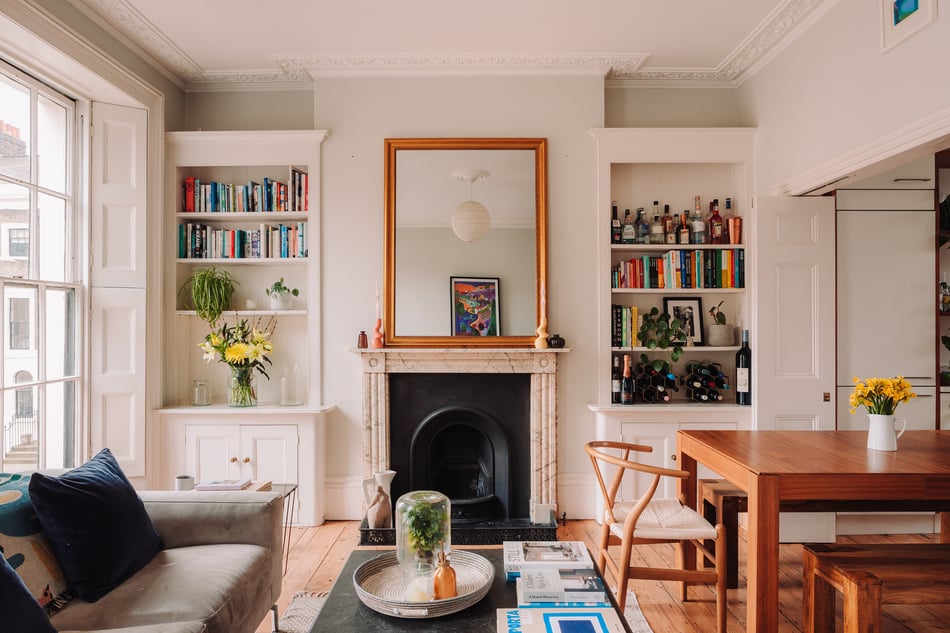
This refined two-bedroom apartment occupies the first floor of a Grade II-listed Georgian townhouse in the Trinity Church Square Conservation Area. Its piano nobile position allows light to flood its living spaces, illuminating original features such as ornate crown moulding and a carved marble fireplace. Tall windows command views over the historic Henry Wood Hall and its formal gardens, open to residents of the square and dotted with tall London plane trees.
Setting the Scene
From 1661, most of the land, including the site of Trinity Church Square, was owned by the Corporation of Trinity House. Horwood’s map of 1798 shows the area was predominantly unbuilt and instead used for grazing and growing, planted with market gardens of kale, mint and horseradish.
The formation of Trinity Street in 1813 marked the beginning of the urban development that formed the basis for the conservation area. Between 1820 and 1850, the dwellings on Trinity Church Square were constructed as the most prestigious homes on the estate, centred around the Holy Trinity Church which was completed and consecrated in 1824. The Corporation required speculative builders to submit plans and elevations detailing the type, design and siting of their proposals for approval, resulting in a uniform architecture of terraces that Pevsner described as “an admirably complete composition”. For more information, please see the History section.
The Grand Tour
Smart London stock brick and stucco façades line Trinity Church Square, where this apartment sits along the north-western side. Steps flanked by spearhead cast-iron railings lead to the front door of the building, the bands of the rusticated ground floor forming voussoirs to the segmental arch in which it is set. Beyond, stairs from the communal hallway lead to the first floor, where the apartment’s private entrance is found.
Entry is to the hallway, where a sisal carpet runs underfoot and walls are washed in a gentle shade of white, a soft palette that sets the tone for the rest of the plan. Opening from one end of the hallway is the reception room, where a pair of tall six-over-six sash windows with original embrasure shutters take in peaceful views over the arboreal gardens opposite. At one side of the room is an original marble fireplace surround with bullseye corner blocks and moulded jambs and frieze. Overhead, 19th-century detail continues with an intricate acanthus cornice. The Bath Stone of the church outside imbues the light with a honeyed tone, making it an inviting place to relax as the sun sets.
Folding doors between the reception room and the kitchen at the rear of the plan can be opened wide to create a wonderful sense of flow between the spaces, ideal for entertaining guests while preparing dinner. The kitchen is composed of white-painted cabinetry that houses a five-ring Rangemaster. A kitchen sink is set below a sash window that overlooks a flowering cherry tree and laurel outside.
Two double bedrooms and a bathroom are arranged around the other end of the hallway. The primary bedroom faces the square and has built-in wardrobes that provide excellent storage. The second bedroom is to the rear of the plan, where built-in shelves are ideal for keeping a personal library or favourite photographs. Next door is the bright bathroom, finished in neat white tiles and with a luxurious rain-style shower.
The Great Outdoors
Residents of the square have access to the beautifully planted gardens in its centre, as well as the gardens in neighbouring Merrick Square. Behind the cast-iron railings are mature London plane trees and cherry trees, with beds planted with santolina, anemones, lavender, cyclamen and daffodils surrounding a statue of which parts are thought to date to the early 2nd century.
Standing in the middle of the square is the Holy Trinity Church which is now known as the Henry Wood Hall and used as a rehearsal studio for the London Philharmonic Orchestra. The dulcet tones of music can often be heard drifting through the square.
Out and About
Trinity Church Square is just south of Borough, an area synonymous with an ever-growing international food scene, an array of excellent restaurants and pubs and beautiful historic architecture.
Borough Market is a short walk to the north and is home to Monmouth Coffee, Neal’s Yard Dairy and a vast array of independent stalls and traders. To the west is Bermondsey Street, known for some of London’s finest restaurants, pubs and cafés, including 40 Maltby Street, Casse-Croûte, WatchHouse Coffee and the renowned St. John Bakery. Lant Street Wine and The Roebuck are also close by for an evening drink.
Tate Modern, Shakespeare’s Globe Theatre, White Cube, and all the South Bank has to offer are within easy reach. There are an array of green spaces nearby in addition to Trinity Church Square, including Tabard Gardens, Leathermarket Gardens and Hankey Place Gardens.
Trinity Church Square is located five minutes from Borough Station (Northern Line), 14 from London Bridge (Jubilee, Northern and National Rail), 15 from Southwark (Jubilee) and 22 from Waterloo (Northern, Waterloo and City, Bakerloo and Jubilee). The City can be reached by foot in under 20 minutes.
Tenure: Leasehold
Lease Length: Approx. 117 years remaining
Service Charge: Approx. £4,700 per annum
Ground Rent: N/A
Council Tax Band: D
History
Now the most complete square in south London, Trinity Square was originally laid out between 1824 and 1832, built on land that once formed part of the much-earlier manor of Walworth. At its centre is the Holy Trinity Church, designed by notable south London church architect Francis Bedford. Despite damage during World War II, the church continued to be used as a place of worship until the early 1960s.
In 1824, William Chadwick applied for a building lease from the Trinity House Corporation to develop houses along the square. Chadwick went on to live at number 29, the largest of the properties, with other famous residents including former RIBA president John Belcher. By the mid-19th century, the homes were inhabited by wealthy but professional families; by 1861, the Lazenby Pickle Factory had been constructed nearby.
The garden has been open to residents since 1997. The origins of a statue of a king on the green have long been disputed, with some believing it to have come from Westminster Hall, which would date its construction to the late 14th century, while some argue it was made for the garden of Carlton House in the 18th century. A restoration project in 2021 nevertheless restored the figure to its former glory.
Although no longer used as a place of worship, the church at the centre of the square has also been embraced in recent times, namely as a permanent rehearsal studio used by the London Philharmonic and London Symphony Orchestra. It was named Henry Wood Hall after the English conductor and opened in 1975 after an extensive assessment of potential and suitable churches in London.
Interested? Let’s talk
Related Listings
- Coastal Collective: five beautiful boltholes a stone’s throw from ocean sprayHomes
- Great and Small: five exceptional cottages worth dreaming aboutHomes
- Historic Heights: six distinctly noteworthy homes, Grade II*-listed and aboveHomes
- A Private View: a self-taught vintage cognoscente shares the lessons learnt during her first renovationHomes / Interiors
- A Private View: the artful home of Robin Welch, the celebrated ceramicist who broke the mouldHomes / Interiors

